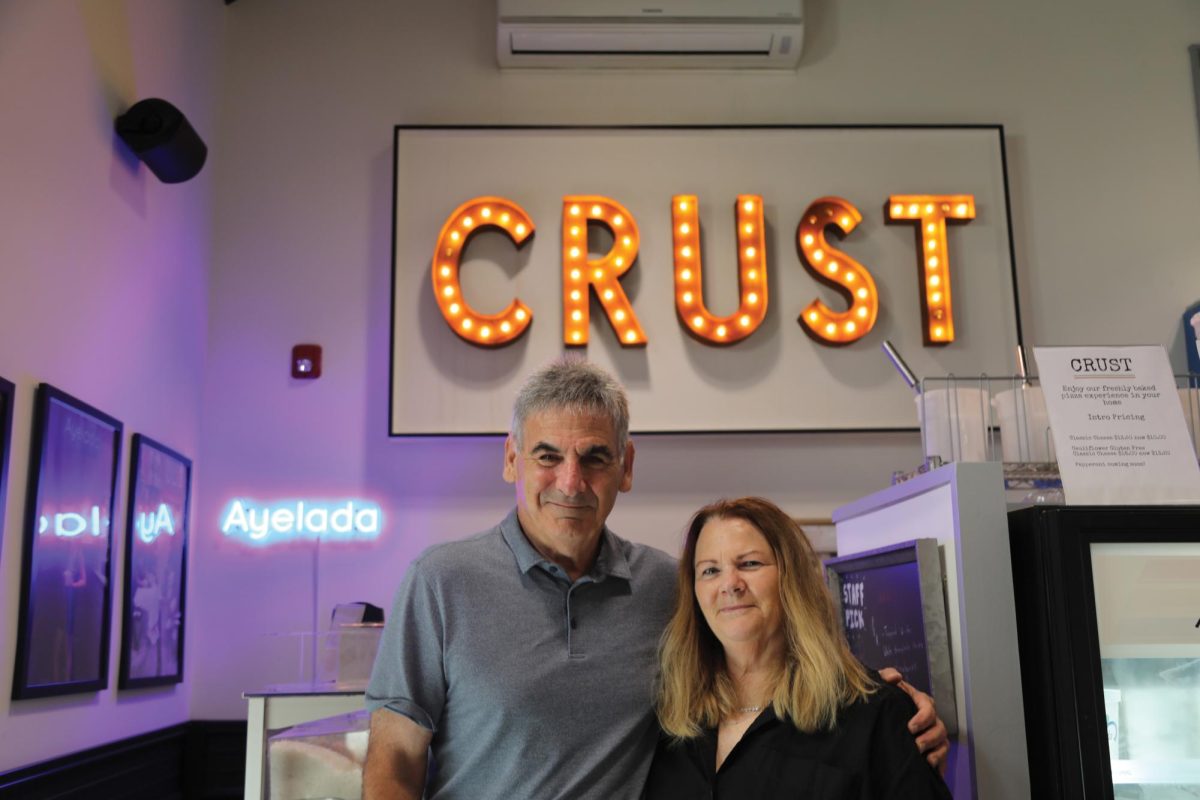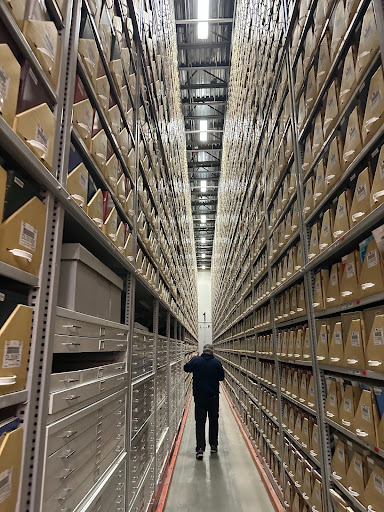
What do a cobalt blue mini piano once used by Bing Crosby and records from early faculty meetings at the College have in common? Both are kept in the College’s Library Shelving Facility (LSF).
Off of Route 7, tucked between the Williamstown Police Station and a field of solar panels, a boxy concrete building sits on an unassuming side road. The LSF looks like a warehouse, and, in many ways, it is. Inside, on shelves that measure nearly 40 feet high, the College stores everything from back runs of academic journals to archival letters — essentially, everything in the College’s multimedia archives that does not fit inside the limited library storage on the College’s campus.
The off-site facility dates back to 2008, built after the original Sawyer Library reached book capacity. As the College began to consider constructing a larger building to replace Sawyer, it determined a second facility was needed, both to store books while a new library was under construction and to hold materials that could not fit on campus, Director of Libraries Jonathan Miller told the Record.
According to Miller, when the College was building the new Sawyer Library that stands today in 2014, faculty were adamant that the entirety of the library’s extensive book collection remain on campus — which is why Sawyer was built with compact shelving to maximize storage space. However, there were plenty of other non-book materials that needed a new off-site home.
“The aim here is to have things that are heavily used up on the campus, and the things that are important — that we want to keep — but are less used [in the LSF],” Miller said.
Among the estimated 270,000 items stored inside the LSF are print copies of old academic journals and boxes of the College’s archival materials, alongside hundreds of vinyl records, VHS tapes, and microfilm. There are larger objects, too, like student artwork from the 1993 Hunger Strike, a fax machine, and, of course, the Bing Crosby piano, which he played while on tour with composer Paul Whiteman. There’s even a small section of a shelf where the College allows the Stockbridge-Munsee Community to store documents or records, though these materials are not managed or processed by the College.
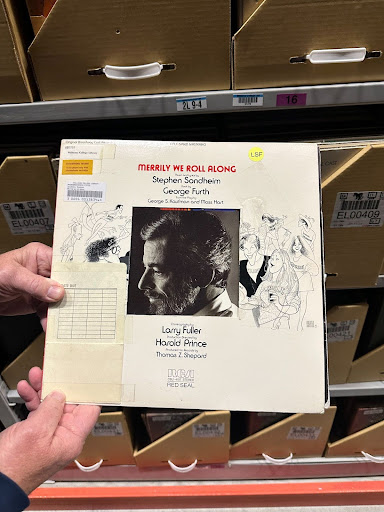
And all these materials are kept at precisely 60 degrees and 40-percent humidity, which the LSF Supervisor Dave Chalifoux said are the ideal conditions to preserve delicate items.
“That’s designed for the books, not for the people,” Miller joked.
“But it’s nice in the summer,” Chalifoux added.
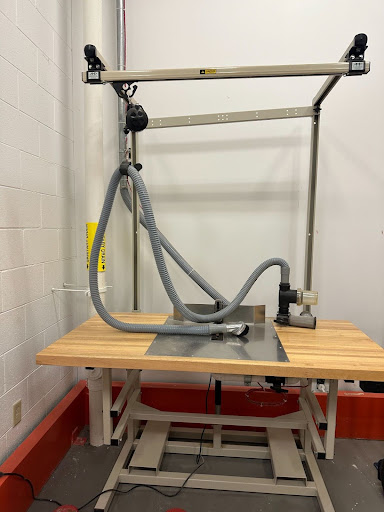
After items arrive at the LSF, they are cleaned with an industrial-sized vacuum and then sorted by size into trays. Once they are in their appropriate tray, the items are given a barcode and entered into the facility’s software. This system is fashioned after the Harvard Depository, what Chalifoux called “the Harvard model.” The LSF’s shelves are designed to be nearly the same size as the items stored on them, which minimizes any gaps between items and maximizes storage efficiency.
As a consequence, however, it is critical that items are correctly barcoded and placed on the appropriate shelves. Otherwise, it’s likely that they would be permanently untraceable, given that there is no alphabetical or subject-based organization system to rely on. So far, Chalifoux said, the LSF hasn’t lost an item — at least that they know of.
Though the facility is out of sight for most members of the campus community, Chalifoux and the small team who staff the LSF are kept busy every day retrieving items for use — both at the College and around the world. When an item is requested, Chalifoux uses the barcoding system to identify its precise location in the shelves, retrieves the item with the assistance of a mechanized lift, and brings it to the facility’s office space. There, Chalifoux creates a scan of the item, which can be emailed to the individual who made the request, or — in rare cases — he packages an item for a mail delivery.
Often, the recipients are not students or faculty — at least not from the College. Sawyer is a member of a much larger interlibrary loan network, Miller explained, meaning the College will freely send academic materials from its collection to other libraries that don’t have them, with the assumption that others will do the same.
“Libraries are really good at cooperating so that we don’t all need to buy the same stuff,” Miller said.
The College is also a member of the Eastern Academics Scholars Trust, a consortium of over 50 academic institutions in the United States with retention agreements for books in their collection. According to Miller, that means Sawyer has more than 100,000 books that it has agreed to permanently retain in its collection. This allows other libraries to deaccession their own copies of those books, knowing they can always borrow them from the College.
The problem of overcrowded shelves, Miller said, is not foreign to the College. When the current Sawyer Library was constructed in 2014, it was built with 10 years of projected growth space. Because of slower-than-expected rates of book purchasing, the library still has a few years of growth before it will hit capacity. But when that time comes, staff will have to determine based on past use and anticipated future use which books should be moved to the LSF.
And there will be plenty of space given that, by Chalifoux’s estimates, the LSF is only at five-eighths capacity.
“We have room to grow, which is the idea, because you always want to plan for the future,” Miller said. “And the future is decades, not years.”
“I’ll be long gone before they think about building anything else,” Chalifoux added.
The LSF shelves also get a bit lighter every year, thanks to “Shred Day.” Over the course of the year, the facility is tasked with storing materials that need to be destroyed. Once a year, a shred truck backs into the LSF garage to collect confidential College paperwork — disciplinary and health records, for example — that will be put through the shredder. Items to be shredded are sometimes collected years in advance: Part of an aisle of the LSF is dedicated to boxes for future Shred Days, each labeled with the year — some as far in advance as 2028.
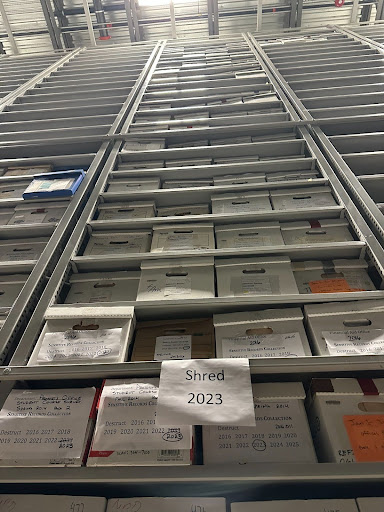
The materials stored at the facility require tight security — both for the sheer number of items and the sensitivity of many of the documents. The building, Chalifoux said, is armed with cameras and motion sensors, and the doors require swipe access from on-site staff to enter (not even Miller’s ID works to open the LSF). And, consequently, staff at the LSF are vetted during the hiring process to ensure they can be entrusted with the items stored in the facility.
“We need to trust Dave — because he has access to this whole place — that he’s going to treat these materials in all of the different ways that [are] important to treat these materials,” Miller explained.
Like the LSF, Chalifoux and Miller’s work may be out of sight and out of mind for many at the College, but both the facility and its upkeep are essential for Sawyer and its connections with other libraries. “It’s hidden labor, but it’s really important for the function of the libraries, and ultimately, the function of the College,” Miller said.
An earlier version of this article incorrectly stated that the College’s Library Shelving Facility was built in 2008 instead of a new library. It was built as a part of a larger library construction plan, which also included a new Sawyer Library that was completed in 2014.




